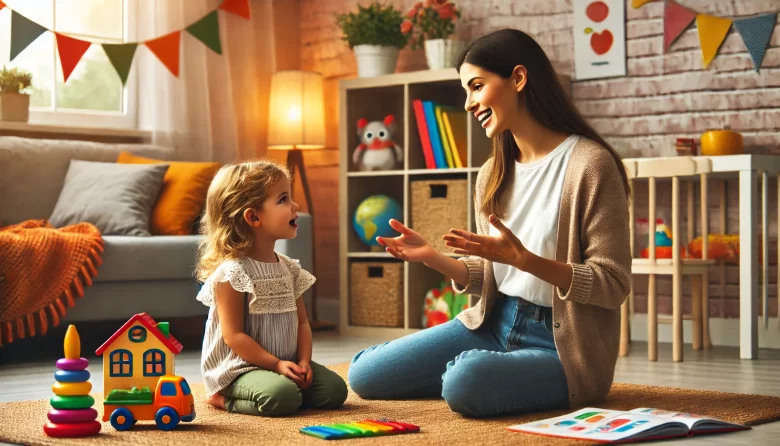Speech and language skills are essential for a child’s overall development, influencing their ability to communicate, express emotions, and interact socially. While every child develops speech at their own pace, parents and caregivers play a crucial role in encouraging language growth from an early age.
By incorporating simple, everyday strategies into daily routines, you can help your child build strong communication skills. In this article, we’ll explore the stages of speech development, practical ways to encourage talking, and fun activities to boost language skills at home.
Understanding Speech Development in Young Children
Every child follows their own speech development timeline, but there are general milestones to look out for:
Typical Speech and Language Milestones
👶 0-6 Months:
✅ Recognizes familiar voices and reacts to sounds.
✅ Begins cooing and making vowel-like sounds.
🍼 6-12 Months:
✅ Responds to their name and simple words (e.g., “no” and “bye-bye”).
✅ Starts babbling with consonants (e.g., “ba-ba,” “da-da”).
🧒 12-18 Months:
✅ Says first words (e.g., “mama,” “dada,” “ball”).
✅ Understands simple instructions like “Give me the toy.”
👦 18-24 Months:
✅ Uses 20-50 words and begins combining two-word phrases (e.g., “want cookie”).
✅ Can point to objects when named.
👧 2-3 Years:
✅ Expands vocabulary to 200+ words.
✅ Forms short sentences (e.g., “I want juice”).
✅ Starts asking “what” and “why” questions.
🎯 Pro Tip: If your child is not meeting these milestones, don’t panic! Every child develops at their own pace. However, if you have concerns, consult a speech therapist.
Practical Ways to Encourage Speech Development
Talk to Your Child Throughout the Day
Narrating daily activities helps children connect words with actions and objects.
Examples of Everyday Speech:
🛁 During Bath Time: “Look at the bubbles! Let’s wash your hands.”
🍎 During Mealtime: “This apple is red. Do you want a big or small piece?”
🚶 During Walks: “I see a dog! The dog is running. What sound does a dog make?”
🎯 Pro Tip: Use clear and simple language, but avoid “baby talk.” Speak in full sentences to model correct speech patterns.
Read Books Together Daily
Reading exposes children to new words, sentence structures, and storytelling.
How to Make Reading Engaging:
📖 Use books with bright pictures and simple text.
🗣️ Ask questions while reading (“What do you think happens next?”).
🦆 Make animal sounds and expressive voices to bring stories to life.
🎯 Pro Tip: Let children “read” by turning pages and pointing to pictures—this builds early literacy skills!
Sing Songs and Nursery Rhymes
Music and rhythm help children remember words and practice pronunciation.
🎶 Great Songs for Language Development:
✅ “Twinkle, Twinkle, Little Star”
✅ “The Wheels on the Bus”
✅ “Old MacDonald Had a Farm”
🎯 Pro Tip: Encourage hand motions and clapping along with the song to improve coordination and engagement.
Use Gestures and Facial Expressions
Nonverbal communication, like pointing and facial expressions, supports language learning.
How to Use Gestures:
👋 Wave while saying “bye-bye.”
👆 Point to objects while naming them.
😲 Use exaggerated facial expressions to show emotions (happy, sad, surprised).
🎯 Pro Tip: Encourage your child to imitate gestures to reinforce meaning.
Repeat and Expand on What Your Child Says
When your child says a word or phrase, build upon it to introduce more language.
Examples of Expanding Language:
🗣️ Child: “Car!”
✅ Parent: “Yes! A big red car is driving fast.”
🗣️ Child: “Want cookie.”
✅ Parent: “You want a cookie? Here’s a yummy chocolate cookie!”
🎯 Pro Tip: Don’t correct mistakes directly—repeat the phrase correctly instead.
Limit Screen Time and Encourage Interaction
Too much screen time can reduce opportunities for real conversation. Instead, focus on interactive play.
Screen-Free Speech Activities:
🧩 Play with building blocks while naming colors and shapes.
🎭 Use stuffed animals to create a pretend-play conversation.
🎤 Have a “talking contest” where you take turns making silly sounds.
🎯 Pro Tip: If your child watches TV, choose educational programs and watch together, discussing what you see.
Fun Activities to Boost Speech Development
“I Spy” Game
👀 Say: “I spy something blue.” Let your child guess what it is!
🎯 Benefit: Improves vocabulary and observation skills.
“What’s in the Bag?”
🎒 Place small objects in a bag. Let your child pull one out and name it.
🎯 Benefit: Encourages curiosity and word recall.
“Animal Sounds” Game
🐮 Parent: “What sound does a cow make?”
🗣️ Child: “Moo!”
🎯 Benefit: Teaches word associations and pronunciation.
“Finish the Sentence” Game
📝 Parent: “The cat is…”
🗣️ Child: “Sleeping!”
🎯 Benefit: Helps sentence-building skills.
How to Respond to Speech Delays
If your child is not talking as much as expected, consider the following:
✅ Reduce Background Noise: Turn off TVs and tablets to encourage focused conversations.
✅ Give More Time to Respond: Some children need extra seconds to process language.
✅ Use More Gestures: Pairing words with gestures can help comprehension.
✅ Seek Professional Help if Needed: If your child shows little interest in communication or struggles to make sounds, consult a speech therapist.
🎯 Pro Tip: Every child is different—avoid comparing them to others!
Final Thoughts
Encouraging speech development in young children doesn’t require special tools or programs—just consistent, meaningful interaction. By talking, reading, singing, and playing with your child, you provide them with the foundation they need to become confident communicators.
Language learning should always be fun, pressure-free, and based on real-life experiences. The more you engage with your child in everyday conversations, the stronger their speech skills will become!




